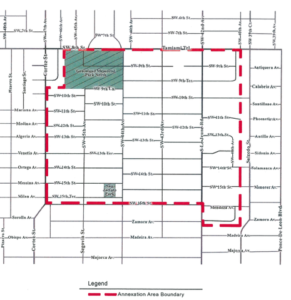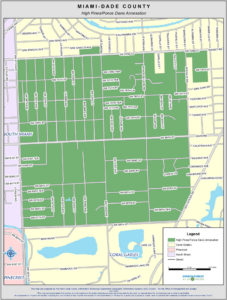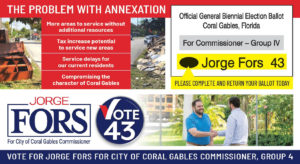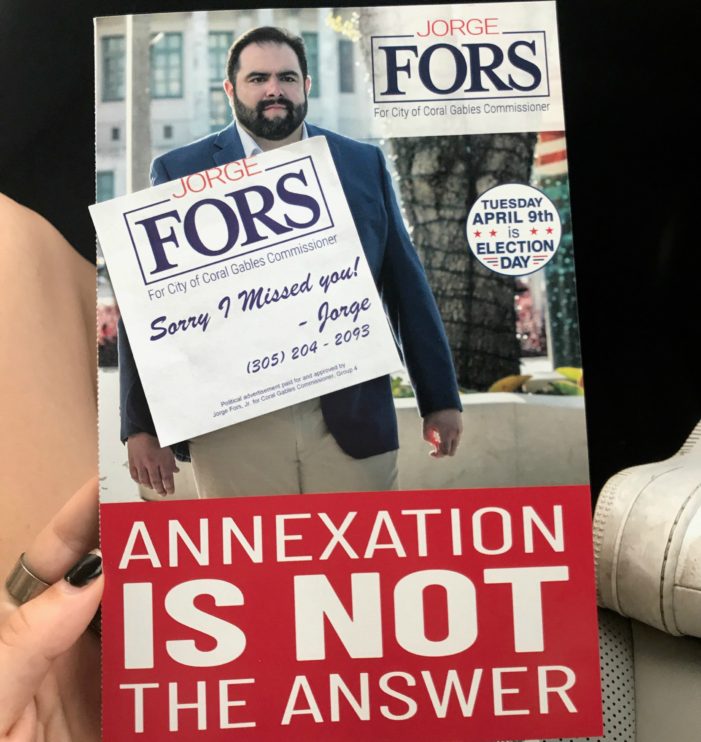In what looks like yet another desperate attempt to gain votes through fear and misinformation, Coral Gables candidate Jorge Fors sent an email blast Wednesday vowing to fight annexation.
But Jorgie-Come-Lately — who apparently hasn’t been to a single town hall meeting on the annexations — got a few things wrong.
“The reality of annexation is that our fire and police department will be forced  to assume responsibility for a larger area and more households without additional resources,” Fors says in an email with a photograph of the “scary” trailer park in Little Gables, which is a sore point with Gables residents.
to assume responsibility for a larger area and more households without additional resources,” Fors says in an email with a photograph of the “scary” trailer park in Little Gables, which is a sore point with Gables residents.
Read related: Coral Gables candidate Jorge Fors stirs annexation fears for votes
“The same problem applies to other departments such as solid waste, code enforcement, public works and the rest of Coral Gables personnel. Eventually, we will need additional resources to service these areas and they will come at a cost to the taxpayers,” he added.
But this is a bunch of lies, or alternative facts maybe. The real facts are:
(1) There are two areas that are planned to be annexed. Miami-Dade County  won’t allow the Gables to “cherry pick” only High Pines and not Little Gables. High Pines is considered a donor area because their tax dollars will surpass the expense of providing expanded services — and probably cover the initial expenses in Little Gables as well. So these additional resources will, indeed, come at a cost to the taxpayers. The new taxpayers. Not the current ones.
won’t allow the Gables to “cherry pick” only High Pines and not Little Gables. High Pines is considered a donor area because their tax dollars will surpass the expense of providing expanded services — and probably cover the initial expenses in Little Gables as well. So these additional resources will, indeed, come at a cost to the taxpayers. The new taxpayers. Not the current ones.
(2) Additional resources will be needed and that’s a good thing. The additional taxes brought in by High Pines could pay for an additional police officer or two or three and more code enforcement officers. These additional resources, however, will not be limited to those areas — not when the boundaries move — and will provide better services to the surrounding neighborhoods of current Gables residents as well.
(3) Police Chief Ed Hudak says it’s a good idea because annexation will  reduce the city’s borders and make it easier to use the “geo-fence” system of cameras that track license plates as vehicles enter and leave the City Beautiful. It is easier to patrol one border rather than three, Hudak said. And because Little Gables is an enclave and it takes Miami-Dade Police and Fire Rescue longer to respond, Coral Gables police and fire respond a lot there anyway. This would be a way to get proactive with that neighborhood and get those property owners to start paying for those services they are getting anyway.
reduce the city’s borders and make it easier to use the “geo-fence” system of cameras that track license plates as vehicles enter and leave the City Beautiful. It is easier to patrol one border rather than three, Hudak said. And because Little Gables is an enclave and it takes Miami-Dade Police and Fire Rescue longer to respond, Coral Gables police and fire respond a lot there anyway. This would be a way to get proactive with that neighborhood and get those property owners to start paying for those services they are getting anyway.
(4) Little Gables and High Pines will be annexed eventually by somebody.  Miami-Dade County has said that it needs all enclaves — which are unincorporated areas surrounded on all sides by municipalities, which makes them difficult and costly to service — to be absorbed into the adjoining municipalities. If Little Gables does not become part of Coral Gables, it will eventually be part of the city of Miami. Which means that it will be under Miami’s zoning and code enforcement and the Gables will have absolutely no control over what is done or built there.
Miami-Dade County has said that it needs all enclaves — which are unincorporated areas surrounded on all sides by municipalities, which makes them difficult and costly to service — to be absorbed into the adjoining municipalities. If Little Gables does not become part of Coral Gables, it will eventually be part of the city of Miami. Which means that it will be under Miami’s zoning and code enforcement and the Gables will have absolutely no control over what is done or built there.
(5) This will be a windfall for the city. A 2017 study indicates that, with both areas annexed, the Coral Gables property tax revenue will grow by almost $82 million over eight years starting in 2020. After expenses due to increased services, there will be a surplus of $37.6 million.
A graphic on the email that looks like it might be a mailer, Fors even asserts  that there could be a tax increase to service the areas and service delays to current residents. Both things are preposterous. If anything, the additional tax revenue — as said earlier, it’s a net gain of about $38 million — could end up lowering taxes for current Gables residents.
that there could be a tax increase to service the areas and service delays to current residents. Both things are preposterous. If anything, the additional tax revenue — as said earlier, it’s a net gain of about $38 million — could end up lowering taxes for current Gables residents.
“His assertions are completely baseless,” Cabrera told Ladra late Wednesday.

“The Coral Gables millage rate will not be raised. The city’s services will not be compromised.
“The chief of police wants to proactively attack a troublesome crime area and wants Little Gables. Fors is interested in only ‘cherry picking’ Ponce Davis and High Pines,” Cabrera added.
“The only thing the city has left to do is approve an inter local agreement with Miami-Dade County to annex these areas. Even if he wanted to, Fors can’t bring this back. He isn’t on the prevailing side.”
That’s true. Fors, if by miracle he is elected, is one vote and can’t stop it. He should stop telling voters that he will.
The annexation was approved by the Gables Commission, after multiple public meetings that Fors did not attend, in November 2017. It was a 3-2 vote, with the yeas coming from Mayor Raul-Valdes-Fauli and commissioners Vince Lago and Pat Keon — all of whom will still be on the dais after the runoff April 23. The annexation is far along in the process. The next step is that the residents of the would-be annexed zones to vote.
Commissioners Mike Mena and Frank Quesada, who is not seeking re-election, voted against the annexation. And because they have the same campaign consultant as Fors, las malas lenguas say the anti-annexation movement aims to protect the hourly no-tell motels on Eighth Street.
Steve Marin told Ladra weeks ago that he had nothing to do with the hotels and had never lobbied on their behalf. There is nothing indicating that he has.

